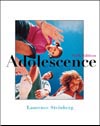| Major Section | Study Guide Features |
| | |
| Some General Principles About | Learning Objectives: 1 |
| Problems in Adolescence | |
| | |
| I.Psychosocial Problems: Their Nature | Learning Objectives: 2 |
| and Covariation | Important terms: substance abuse, |
| | internalizing disorder, externalizing disorder, comorbid Multiple choice questions: 2, 3, 29 Fill in the blank questions: 1 Matching questions: 1, 8 |
| | |
| A.Problem behavior syndrome | Learning Objectives: 3 |
| | Important terms: problem behavior theory, problem behavior syndrome, risk-taking behavior, social control theory, Richard Jessor, Denise Kandel Multiple choice questions: 1, 4 Fill in the blank questions: 2 Matching questions: 2, 7, 13, 19 |
| | |
| B.Comorbidity of internalizing problems | Important terms: negative affectivity |
| | Multiple choice questions: 5 |
| | |
| II. Substance Use and Abuse in Adolescence | |
| | |
| A. Prevalence of substance use and | Learning Objectives: 4 |
| abuse in adolescence | Important terms: Monitoring the |
| | Future, gateway drugs Multiple choice questions: 6-11, 30 Fill in the blank questions: 3-5, 7 Matching questions: 4 |
| | |
| B.Cause and consequences of | Learning Objectives: 4 |
| adolescent substance use and abuse | Important terms: risk factors, |
| | protective factors Multiple choice questions:12, 13, 31 Fill in the blank questions: 6 Matching questions: 14 |
| | |
| C.Prevention and treatment of | Learning Objectives: 5 |
| substance use and abuse | Multiple choice questions: 14 |
| | |
| III. Antisocial Behavior, Violence and | Learning Objectives: 6 |
| Other Externalizing Problems | Important terms: status offenses, |
| | violent crimes, property crimes Multiple choice questions: 15 Fill in the blank questions: 8 Matching questions: 5, 12, 18 |
| | |
| A.The prevalence of antisocial | Learning Objectives: 19, 20, 22, 23 |
| behavior in adolescence | Multiple choice questions: 16, 32 |
| | Fill in the blank questions: 9-10 |
| | |
| B.Causes of anti-social behavior | Learning Objectives: 6 |
| | Important terms: attention deficit hyperactivity disorder, hostile attributional bias, life-course persistent antisocial behavior, adolescence-limited anti- social behavior Multiple choice questions:17-21 Fill in the blank questions:12-14 Matching questions: 11, 17 |
| | |
| C.Prevention and treatment of | Learning Objectives: 7 |
| externalizing problems in adolescence | Fill in the blank questions: 11, 15 |
| | |
| IV.Depression, Suicide and Other Problems | |
in Adolescence | |
| | |
| A.The nature and prevalence | Learning Objectives: 8 |
| of adolescent depression | Important terms: depression |
| | Multiple choice questions: 22-23 Fill in the blank questions: 16 |
| | |
| B.Why Are There Sex | Important terms: oxytocin |
depression? | |
| | |
| C.Adolescent suicide | Learning Objectives: 9 |
| | Multiple choice questions: 23 Fill in the blank questions:18-20, 25 |
| | |
| D.Time-Space Clustering | Learning Objectives: 9 |
| of Teenage Suicide | Important terms: epidemiology, |
| | cluster suicides Multiple choice questions: 25, 34 Matching questions: 10,15 |
| | |
| E.Causes of adolescent depression | Learning Objectives: 10 |
| and internalizing disorders | Important terms: diathesis-stress |
| | model, primary prevention, secondary prevention Multiple choice questions: 26 Fill in the blank questions:21-23 Matching questions: 3, 16 |
| | |
| V. Stress and Coping in Adolescence | Learning Objectives: 11 |
| | Important terms: resilience, primary control strategies, secondary control strategies Multiple choice questions: 27, 35 Fill in the blank questions: 24 Matching questions: 6, 9 |



 2002 McGraw-Hill Higher Education
2002 McGraw-Hill Higher Education